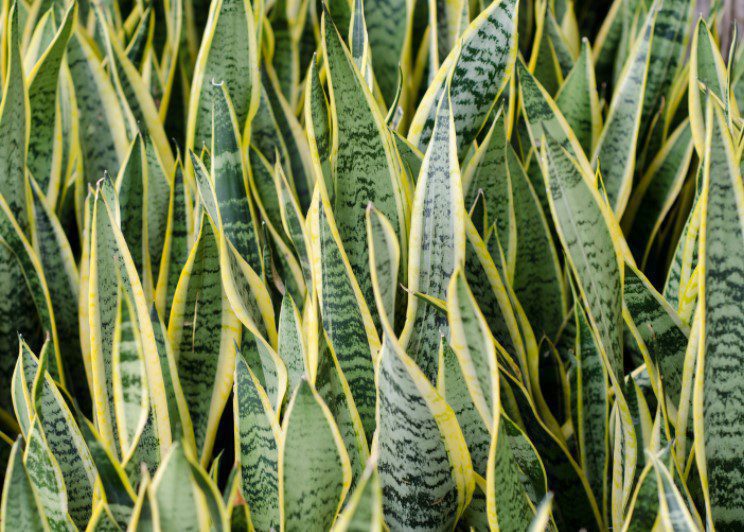Sansevieria (mother-in-law’s tongue)
Sansevieria is a small genus of evergreen perennials native to South Africa. The erect, sword-shaped leaves can reach 1.5 m under ideal conditions, though they rarely attain this height in the average home.
Low growing selections retain a more compact rosette form well suited to dish or bowl gardens.
It is an extraordinarily forgiving plant, tolerant of low light, low humidity, infrequent watering, and largely untroubled by pests and diseases. As long as you avoid overwatering
— the most frequent cause of death — and exposure to cold temperatures, they can survive the fumbling efforts of even the most hapless gardeners.
Apart from its tough, enduring nature, Sansevieria is grown for its spiky, boldly architectural foliage. The leaves are dark green, marked with cross bands of paler grey or yellow-green in various patterns.
One of the most popular taller forms, S. trifasciata `Laurentii,’ has a distinct yellow margin running along with the leaf. ‘Hahnii’ is another widely available cultivar, forming a compact, distinctly funnel-shaped rosette; `Golden Hahnii’ is similar, broadly edged with yellow.
Sansevieria is best grown in diffused sunlight or moderate daylight.
Growing Sansevieria
A room with an east-facing window is ideal, but an unobstructed northern exposure will provide sufficient light to allow these plants to survive, if not thrive. Give them normal room temperatures and water moderately, allowing them to dry to a soil depth of 2.5 to four cm before watering again.
Don’t let them sit in water, as this is almost certain to induce a severe case of root rot. Fertilize occasionally during the summer while actively growing, but reduce watering and skip fertilizing over the winter months. Normal room humidity is usually adequate.
Sansevieria rarely requires repotting — one of its many low maintenance features — as they are quite tolerant of cramped growing conditions. If roots are literally bursting the existing pot at the seams, replant in regular potting soil in a clay or plastic container with adequate drainage holes.
How To Care For Sansevieria
Few plants can offer such a wide range of sizes and colors, making them perfect for modern houseplants. They look a lot like bearded Iris, with their thick, shallow rhizomes that travel underground to expand the colony.
They can even tear apart nursery pots if they are allowed to grow for too long. The gradual root growth and pressure increases send the rhizomes to the drain holes, where they will likely sprout new leaves.
It’s simple to divide Sansevieria houseplants. This succulent doesn’t wilt and can be removed from their pots. Allow the pieces to rest in the open for a few more days until the callus is gone.
This will prevent soil pathogens from entering the root after being transplanted into a new container or location.
Sansevieria make excellent patio plants, especially when used in a modern and sparse design. These plants are great for use under covers, where the sun is not a problem. These succulents prefer shade and are often found under tree canopies to protect them from the direct summer sun.
These plants are great to enjoy. Choose the ones that complement your decor. They stand out against white walls better than dark green ones. For a cute effect, they can be placed in pots near the floor and ceiling windows. If you want to recreate the colonial Mexican look, plant them in Terracotta.
These tough-as a mother-in-law leaf plants are for those who have had a bad experience with houseplants and want to make their home greener. They can’t be killed. That’s why they keep coming back for more.
They are resistant to heat, drought heat, low lighting, digging dogs, house cats, and bugs. These plants are frost-sensitive, so it is important to remember this.
Sansevieria Trifasciata
Sansevieria Trifasciata is also known as Snake Plant is the most sustainable houseplant. Its beautiful variegated yellow leaves are trendy.
Other species are less visually appealing, but they offer rare and uncommon options for hot, dry areas.
Some are new exotic hybrids. Enjoy the summer and then bring it inside for winter.
If you wish to keep the plant in a smaller pot, large specimens can easily be divided by splitting the underground stem (called a rhizome) with its attached roots and leaves into two or more clumps.
Leaf cuttings can also be used for propagation simply by taking sections five to 10 cm long from a healthy leaf and rooting them in moist sand or a mixture of sand and perlite.
Place the cuttings bottom side down in the medium, or they will not form roots — yes, plants do know up from down — and partially cover with plastic or mist regularly to provide a little extra humidity.
Transplant to a bigger pot when roots are well established. You can easily propagate many little sansevierias in this way; the one drawback is that yellow-edged types will revert to their green form.
To maintain the variegation, multiply by division rather than cuttings.



























Comments are closed.